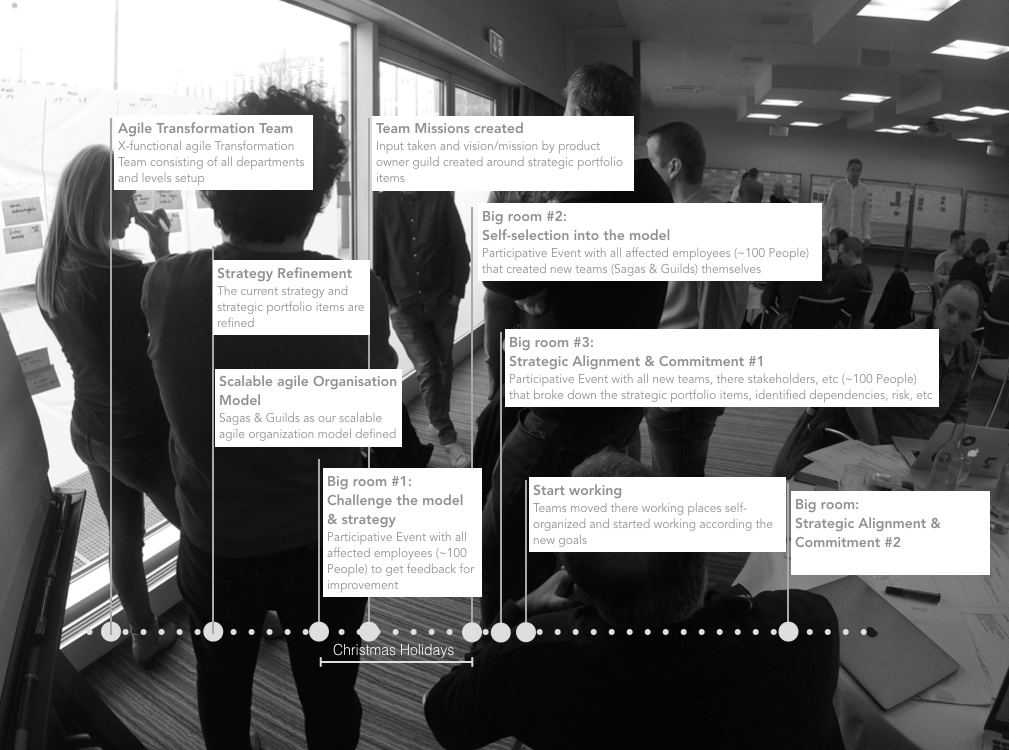Swisscom Directories AG faced the challenge of transforming already agile- with classically organized company parts to a large whole new agile organization. The transformation team went different path, namely a participative agile transformation with several large group events. The journey reached its first peak as the employees formed their own teams through self-selection. In this serie of blog posts we'd like to share the challenges we faced, our experiences and the results of our joint work in the agile transformation team at Swisscom Directories AG.
In this blog post, we retrospectively look back at the 3 Big Room Events, each with around 100 employees. What was good, what could be improved and what would we do differently today?
Back to the previous Article of the story: Self-selection @ Scale - Strategic alignment of the Sagas (Episode 4)
“The Big Room Events series was definitely a great success for us and also encouraged social integration between management, business and engineers. ”
Retrospective
Less than the Christmas holidays the 3 Big Room events were running within a few weeks. The lead time up to the 1st Big Room, including the initialization of the transformation team, amounted to approx. 2-3 months, but the Big Rooms were prepared within one month incl. learning curve.
Rough sequence of the 3 Big Room Events, Source Localsearch, 2017
What was good
- The management set date for the 1st Big Room encountered first on rejection, since it was top-down set. However, it turned out that this had a positive effect on the preparation of the large group event and corresponding energies got released.
- Simply throwing the people into the cold water, without much preparation / introduction, seemed irresponsible at a first look. On a second look, this effort would have been unrelated and we wanted to follow our credo: "learning-by-doing".
- The creative tension curve over the 3 events, or within each individual Big Rooms was very important and led to it always remained interesting or the employees motivated with.
- The transformation team initially had little experience in organizing and running a big room. Nevertheless, the transformation team got the confidence by the management. This was very important and one of the main success criterias.
- To risk something and learn from the failures developed the organization further, than doing nothing.
What could be improved
- Monitoring of satisfaction before, during and after the big rooms did not take place systematically. Today, we would be interested in what people think at any time, whether they made their first choice, etc.
- The strict separation of individual fates at the Big Room for the benefit of all we had planned and then not followed consistently. It caused unrest and disturbed the Big Room.
- The discussion about the line organization could be rejected in the short term. This should be completely separated from the big rooms.
- Responsibility for communication between management, transformation team and employees was somewhat ambiguous and led to some misunderstandings.
- Despite an agile procedure, as it was unclear how many events it will take, it is advisable to create a rough Go Product Roadmap and avoid private- and public holidays at an early stage.
What would we do differently today?
- In terms of the Big Rooms, our most important learning was certainly to trust more in the self-selection skills through the organization. Iow. today we would have the Sagas formed directly from the guilds and the employees not by a suggested with a best guess.
- The change in the line organization made it difficult for the transformation team to bring the new management in the field of agile leadership and management 3.0 to a common denominator. This is what we see today as basic prerequisites for embedding the Sagas / Guilds in the organization.
- At the 3rd Big Room, other employees such as stakeholders, business owners, etc were added. It turned out that we gave their changed roles, competences, etc., were given too little weight . It is recommended, for example, to collect their worries and fears in a separate mixed event, or to develop a joint understanding about the new agile roles together.
What's next?
The participatory real-time transformation was a complete success. It is now necessary to take the learnings and to improve on the localsearch model, the cooperation / process organization, the line organization, as well as the next BRP. The transformation or the journey has just begun.
Many thanks to Colin Griel and the entire transformation team of Localsearch, without you this would not have been possible!
Author



